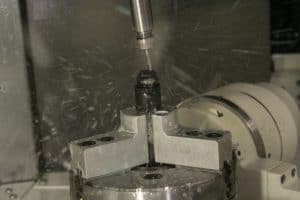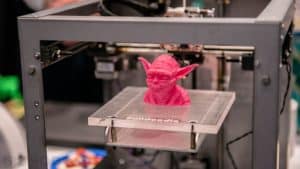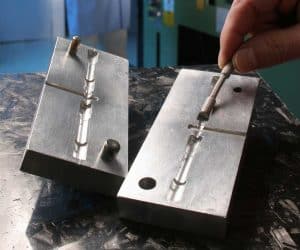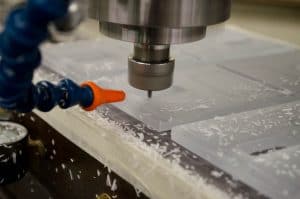 There’s no doubt that plastics have become more and more popular in modern medicine. Short lead times are essential in this industry, and both 3D additive manufacturing and CNC machining provide fast production times. When is your medical application better suited for 3D printing, though, and when does precision plastic machining have the upper hand in plastic manufacturing?
There’s no doubt that plastics have become more and more popular in modern medicine. Short lead times are essential in this industry, and both 3D additive manufacturing and CNC machining provide fast production times. When is your medical application better suited for 3D printing, though, and when does precision plastic machining have the upper hand in plastic manufacturing?
There are a few key differences and similarities between these types of plastic manufacturing that you should keep in mind for your medical applications. It helps to have a basic understanding of each manufacturing process, first.
Subtractive vs Additive Manufacturing
Subtractive Manufacturing
CNC machining is a type of “subtractive manufacturing.” This means that the process generally begins with a solid block of plastic material which is cut or shaped into the desired product through “removing” excess material.
While CNC machining requires more initial setup than 3D printing, it offers repeatability, accuracy for both large and small parts, and a wide range of polymers and composites to choose from, as well as a variety of surface finishes. It scales easily between one-time jobs and high-volume production.
Additive Manufacturing
3D printing is “additive manufacturing,” which means the initial material is built layer by layer, rather than removed as in subtractive manufacturing. 3D printing creates three-dimensional objects from reading a digital file’s blueprint. When working with plastics, you’re primarily talking about FDM 3D printing. While FDM is widely considered the most quick and cost-effective way of producing custom thermoplastic parts and prototypes, it also has the lowest dimensional accuracy and resolution of any other 3D printing technology.
Another option for additive manufacturing is SLS 3D printing, which fuses together the particles of thermoplastic polymer powders. This version of 3D printing has higher accuracy than FDM; however, it comes at the cost of longer lead times, which can be expensive in the medical industry.
Choosing the Right Technology for Your Medical Application
As always, choosing the correct technology is dependent on your particular medical application. What you value in your completed product can help determine which style of plastics manufacturing works best for your needs. Some of your considerations should be:
Material Consultancy
Both CNC machining and additive manufacturing work with a wide variety of thermoplastics, but those plastics react to manufacturing in different ways. Some materials machine more easily than others, while certain thermoplastic materials are more prone to warping in 3D printing.
Your manufacturer should be familiar with your chosen material and be able to discuss the process of machining or 3D printing it with you. At AIP Precision Machining, we have 35+ years of material and machining expertise and we include consultancy as an integral part of our manufacturing process.
Mechanical Properties
CNC machining ultimately provides greater dimensional accuracy and better performing properties than additive manufacturing. Machined thermoplastics possess both great mechanical and thermal properties with fully isotropic behavior. If your product requires unique, strong design with critical tolerances, then FDM 3D printing may not be not ideal; this type of printing is inherently anisotropic, meaning it isn’t the best option for mechanically critical components.
Medical applications, in particular, have unique considerations that ought to be taken into account, both for choosing your initial material and determining how it ought to be manufactured.
Precision Tolerances
Precision CNC machining provides close tolerances for your applications with a fine, burr-free finish. In fact, 3D printed products for the medical field regularly go into CNC machining post-processing as a secondary step in order to accomplish better tolerances or a finishing cut, as FDM parts tend to have visible layer lines.
Extreme tolerances up to 0.002mm can be produced by AIP Precision Machining, which can be necessary in demanding industries such as the medical, aerospace and energy markets.
Quick Turnaround
Both CNC machining and 3D printing have quick turnarounds, especially when compared to injection molding. Machining designs are crafted on the same computer applications used by 3D printers, so there is no cost associated with design changes for either type of plastics manufacturing. However, when time is truly critical, 3D printed parts can be delivered in 24 hours. Quality and functional usefulness, in this case, may be sacrificed for expediency.
AIP Precision Machining can guarantee your complex polymers machined in as little as 10 business days, with quality assured from concept to completion.
Volume of Production
Smaller batches, such as 1-10 plastic components, can be more cost-effective if produced with additive manufacturing. This is because using a non-standard blank size increases the cost of machining. Plastic machining, however, easily scales between small and large outputs.
If you require a high-quality product that possesses extreme mechanical and thermal strength, it is worth precision machining for that reason alone.
The Final Consideration? Experience.
The medical field often has no room for error when it comes to implants, spinal devices and orthopedic equipment. This is why—no matter what type of plastic manufacturing you choose—you want to be sure you’re working with an expert who understands the importance of sterilization, biocompatibility, and other traits that may be necessary for your application.
AIP is FDA and ISO 13485:2016 registered and has been audited by some of the most stringent OEMs in the orthopedic and medical device industries. We process our plastics with strict hygienic procedures.
Whoever you work with, be sure they understand the needs of your industry and have the experience to prove it.
Click here to learn more about the utility of each technology with regard to precision efficiency, materials and more.
Or, request a quote with AIP Precision Machining here.



